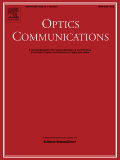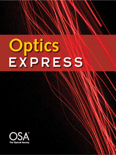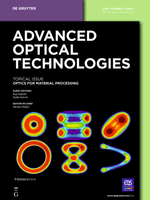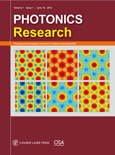
OPTICS COMMUNICATIONS
Scope & Guideline
Connecting Ideas Through Light and Innovation
Introduction
Aims and Scopes
- Optical Communications:
The journal extensively covers advancements in optical communication technologies, including fiber optics, free-space optics, and visible light communications (VLC). This includes research on modulation formats, signal processing techniques, and multi-user communication systems. - Photonics and Metamaterials:
Research related to photonic devices and metamaterials is a key focus area, emphasizing the design, fabrication, and application of new optical materials and structures that can manipulate light in novel ways. - Sensing Technologies:
Optics Communications features studies on various optical sensing technologies, including fiber optic sensors, surface plasmon resonance sensors, and other innovative sensor designs that leverage optical phenomena for measurement and detection. - Imaging and Optical Metrology:
The journal publishes works related to imaging techniques and optical metrology, including holography, interferometry, and advanced imaging systems that enhance resolution, depth, and contrast. - Nonlinear Optics and Laser Technology:
Research in nonlinear optics, including soliton dynamics, laser technologies, and ultrafast phenomena, is prominently featured, highlighting advancements in laser design and its applications in communications and sensing.
Trending and Emerging
- Advanced Metasurfaces:
There is a growing emphasis on the design and application of metasurfaces for manipulating light at subwavelength scales, enabling functionalities such as holography, beam steering, and polarization conversion. - Quantum and Nonlinear Optics:
Research in quantum optics, particularly involving entangled photons and quantum communication, is gaining traction, reflecting the increasing interest in quantum technologies. - Machine Learning Applications:
The integration of machine learning and artificial intelligence in optical systems, particularly for image processing, signal recovery, and system optimization, is an emerging trend. - Terahertz Technology:
There is a notable increase in research focused on terahertz (THz) technologies, including THz imaging and sensing, reflecting its potential in various applications from communications to biomedical fields. - Flexible and Wearable Optics:
The development of flexible, lightweight optical devices for wearable technology is rapidly expanding, highlighting the intersection of optics with materials science and engineering.
Declining or Waning
- Classical Optical Devices:
Research on traditional optical devices such as basic lenses and mirrors has decreased, likely due to the rise of more complex photonic structures and metamaterials that offer enhanced functionalities. - Basic Laser Technologies:
The focus on fundamental laser technologies seems to be declining as new and advanced laser systems with specific applications (e.g., ultrafast, fiber lasers) take precedence in research. - Standard Imaging Techniques:
Common imaging methods without innovative enhancements, such as basic microscopy techniques, have seen less attention in favor of more advanced imaging methods that incorporate machine learning and computational techniques. - Static Optical Sensors:
Static optical sensors that do not leverage advanced materials or dynamic capabilities are becoming less common, as research shifts towards more sensitive and adaptable sensing technologies. - Traditional Communication Protocols:
Research on conventional communication protocols within optical systems is diminishing, likely influenced by the rapid development of new modulation formats and signal processing techniques.
Similar Journals

OPTICS EXPRESS
Exploring the Frontiers of Light and MatterOPTICS EXPRESS is a premier peer-reviewed journal published by the Optica Publishing Group, specializing in the rapidly evolving fields of Atomic and Molecular Physics and Optics. With an impressive Q1 ranking in its category and positioned in the 75th percentile among leading journals in Physics and Astronomy, OPTICS EXPRESS serves as a vital platform for disseminating innovative research findings. Since its inception in 1997 and transitioning to Open Access in 1998, the journal has ensured that groundbreaking scientific contributions are accessible to a global audience, fostering collaboration and advancement in optical science. Additionally, with annual publications converging from 1997 to 2024, this journal not only tracks the latest advancements but also shapes the future landscape of optics research. Whether you are a seasoned researcher, a dedicated professional, or a passionate student, OPTICS EXPRESS offers a wealth of knowledge and a commitment to excellence in the optics community.

Current Optics and Photonics
Connecting Minds in the Realm of PhotonicsCurrent Optics and Photonics is a premier journal published by the Optical Society Korea, focusing on the dynamic and evolving fields of optics and photonics. With an ISSN of 2508-7266 and E-ISSN 2508-7274, it provides a comprehensive platform for scholarly communication, emphasizing innovations, advances in technology, and theoretical developments in atomic and molecular physics and optics. Situated in South Korea's vibrant academic landscape, this open access journal aims to bridge the gap between theoretical research and practical applications, fostering collaboration and knowledge sharing among researchers, professionals, and students alike. Although currently ranked in the Q3 category for both Atomic and Molecular Physics and Optics, with a Scopus rank of #183/224, it showcases significant contributions that enhance understanding in these critical areas. The journal encourages submission of original research articles, reviews, and technical notes, with the objective of driving forward the conversation in optics and photonics throughout its converged years from 2017 to 2024. Embrace the opportunity to contribute to this expanding field and become part of a community that is at the forefront of scientific discovery.

Advanced Optical Technologies
Exploring the Frontiers of Light and InnovationAdvanced Optical Technologies is a reputable journal dedicated to advancing the field of optics and photonics, published by FRONTIERS MEDIA SA in Switzerland. Since its inception in 2012, the journal has made significant contributions to the domains of Atomic and Molecular Physics, Electronic, Optical and Magnetic Materials, and Instrumentation, achieving commendable rankings within these categories, including a Q2 quartile classification in 2023. With an emphasis on open access, Advanced Optical Technologies aims to facilitate the rapid dissemination of research findings, thereby fostering collaboration and innovation among researchers, professionals, and students alike. The journal serves as an essential platform for cutting-edge research articles, reviews, and technical notes, and its commitment to quality is reflected in its robust Scopus rankings. As the field of optical technologies continues to expand, this journal plays a crucial role in highlighting pivotal advancements and promoting interdisciplinary dialogue among scholars in the scientific community.

OPTICAL REVIEW
Pioneering Discoveries in the Field of OpticsOPTICAL REVIEW is a distinguished journal published by the Optical Society of Japan that serves as a critical platform for researchers, professionals, and students within the diverse fields of atomic and molecular physics and optics. With its ISSN 1340-6000 and E-ISSN 1349-9432, the journal has had a significant impact on the dissemination of knowledge since its inception in 1994, with a planned coverage until 2024. Although it currently holds a Q4 ranking in the 2023 category quartiles and is positioned at rank #152 out of 224 in the Scopus database, its contributions are vital for advancing optical science. This journal provides a venue for innovative research, review articles, and significant developments that drive the optical sciences forward. Although not categorized as Open Access, it remains an important resource for those seeking to deepen their knowledge and engage with leading-edge research in optics. With its base located at the Kudan-Kita Building in the heart of Tokyo, Germany, OPTICAL REVIEW is poised to continue fostering scholarly communication and collaboration on a global scale.

Journal of Optics
Illuminating the Future of OpticsThe Journal of Optics, published by IOP Publishing Ltd, stands as a pivotal platform for disseminating cutting-edge research in the fields of atomic, molecular physics, and optics as well as electronic, optical, and magnetic materials. With an impact factor reflective of its esteemed position—ranking in the 60th percentile in both relevant Scopus categories—this journal, boasting an ISSN of 2040-8978 and an E-ISSN of 2040-8986, is uniquely positioned to foster innovation and collaboration among researchers, professionals, and students worldwide. Located in the United Kingdom and operational since 2010, the journal embraces an open access model, promoting maximal reach and engagement with the latest discoveries that shape the future of optics. As it continues to evolve through its converged years up to 2024, the Journal of Optics remains a critical resource for those seeking to advance their knowledge and influence in this dynamic field.

APPLIED OPTICS
Advancing Knowledge in Photonics and BeyondApplied Optics, published by Optica Publishing Group, is a prestigious journal dedicated to the field of optics and photonics. With an ISSN of 1559-128X and an E-ISSN of 2155-3165, this journal serves as a critical platform for researchers, professionals, and students eager to disseminate innovative findings and advancements in applied optics. Established in 1962, it has maintained a significant presence in the academic community, currently holding a Q2 category ranking in various disciplines including Atomic and Molecular Physics, Electrical and Electronic Engineering, and Miscellaneous Engineering as per the 2023 metrics. The journal's reputation is underscored by its solid Scopus rankings, attesting to its influential research output. While not an open-access journal, it continues to offer vital insights and discussions on the latest research topics that are critical to the advancement of technologies in optics, ensuring accessibility to vital knowledge for those within the field.

Chinese Optics
Fostering Breakthroughs in the World of Light.Chinese Optics is a premier journal dedicated to advancing the field of optics, encompassing research on atomic and molecular physics. Published by the esteemed Changchun Institute of Optics Fine Mechanics & Physics in China, this journal supports the sharing of cutting-edge findings since its inception in 2010. With an ISSN of 2097-1842, it operates within a competitive landscape, currently positioned in Q3 of the category for Atomic and Molecular Physics and Optics, according to the 2023 metrics. While the journal is not open access, it offers a valuable platform for researchers, professionals, and students to explore and contribute to significant discoveries in the realm of optics and light technology. By fostering scholarly communication, Chinese Optics plays a crucial role in bridging theoretical and practical aspects, making it an indispensable resource for those passionate about the optical sciences.

Photonics Research
Illuminating the Future of PhotonicsPhotonics Research, published by Chinese Laser Press, is a premier international journal that aims to disseminate cutting-edge research and advancements in the field of photonics, encompassing areas such as atomic and molecular physics, optics, and materials science. Since its inception in 2013, this journal has established itself as a vital resource for academics and professionals, reflected in its impressive Q1 rankings in both Atomic and Molecular Physics, and Optics (15/224) and Electronic, Optical and Magnetic Materials (26/284) as per Scopus, underscoring its influence within the scientific community. With substantial contributions to the field, Photonics Research continues to foster innovation and collaboration among researchers, serving as an essential platform for the publication of high-quality studies that push the boundaries of knowledge. The journal operates on an open-access model, ensuring that research is readily available to a global audience, thereby enhancing its accessibility and impact. Whether you are a researcher, student, or professional, engaging with this journal offers a significant opportunity to stay at the forefront of photonic technologies and ideas.

OPTICAL AND QUANTUM ELECTRONICS
Pioneering Research in Atomic and Molecular FrontiersOPTICAL AND QUANTUM ELECTRONICS, published by SPRINGER, is a premier journal dedicated to advancing the fields of atomic and molecular physics, optics, and electronic engineering. With an ISSN of 0306-8919 and an E-ISSN of 1572-817X, this journal has established itself as a vital resource for researchers, professionals, and students alike, contributing to the discourse from its inception in 1969 to its continued publications through 2024. It holds impressive rankings in Scopus, placing within the top percentiles for its categories, specifically in the 64th for Electrical and Electronic Engineering and 63rd for Atomic and Molecular Physics. Though it does not currently offer open access options, the journal's robust impact factor reflects its importance within its field, making it an essential reference point for cutting-edge research and developments in materials science and optics. Through its rigorous peer-review process, OPTICAL AND QUANTUM ELECTRONICS remains committed to publishing high-quality, influential studies that push the boundaries of innovation and understanding in these dynamic areas of science.

ACTA OPTICA SINICA
Unveiling the Science of Light and MaterialsACTA OPTICA SINICA is a distinguished journal dedicated to the field of optics and photonics, published by the Chinese Laser Press. With an ISSN of 0253-2239, this journal has been an essential resource since its inception, covering significant discoveries and advancements in atomic and molecular physics, electronic materials, and optical sciences. The journal is indexed in Scopus, achieving respectable ranks as Q3 in both Atomic and Molecular Physics, and Optics and Electronic, Optical and Magnetic Materials, reflecting its engagement with current research trends. Although it is not an open-access journal, ACTA OPTICA SINICA is hosted from Shanghai, China, and continues to serve as a vital platform for researchers, professionals, and students alike to disseminate and access high-quality peer-reviewed articles, ensuring its prominent place in the academic discourse related to optics and material sciences.